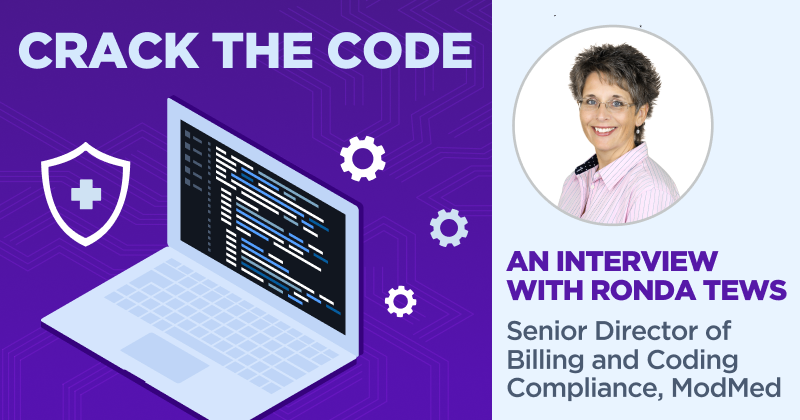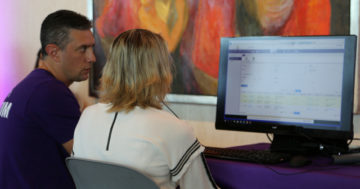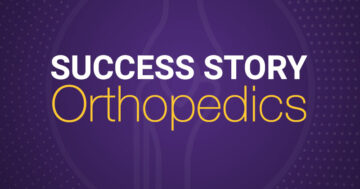Exploring and Overcoming Medical Coding Challenges

The field of medical coding plays a critical role in healthcare revenue cycle management. However, practices face numerous challenges, including staffing challenges, limited in-person training opportunities, and the ever-changing complexity of coding guidelines and payer-specific requirements. To address these challenges, healthcare organizations are turning to software solutions that leverage technology to help. We sat down with ModMed® Senior Director of Billing and Coding Compliance Ronda Tews to explore the top medical coding challenges in the industry and to discuss how software may help.
ModMed: Have you encountered situations where there were not enough certified medical coders or trained billers? How did the shortage affect practice operations?
Ronda Tews: Yes. During my time working in a large healthcare system, my responsibilities included auditing physicians. Many practices did not employ certified coders due to the additional costs associated with their specialized expertise and continuous education. This gap led to very limited knowledge of coding guidelines, modifiers and appropriate coding within those practices. As a result, it became challenging for them to submit accurate claims, leading to increased denials from payers and higher liabilities.
ModMed: Can you give a real-life example of a coding error that might occur in a practice short on coding help?
Ronda: Sure! Let’s say you have a physician who’s going to do a shoulder repair surgery. The plan is to repair, but the physician sees that there’s another area within the shoulder that needs to be cleaned up. The physician’s intent was to do the repair, then saw this other item that needed to be done and decided to complete both at the same time.
Both the repair and doing the cleanup could have their own CPT codes, but both codes are not always billable together. That’s why there are national coding guidelines and edits in place. Some codes are bundled together as a component of another code. When you unbundle codes, you’re breaking them apart and trying to bill both of them for the same body area, which isn’t always allowed.
ModMed: Is medical coding distinct from medical billing?
Ronda: Medical coding and medical billing are often treated as separate functions, but they can overlap, especially in smaller practices. Traditionally, medical coders were expected to have knowledge in both billing and coding. However, with advancements in coding technology and more intuitive EHR systems, the distinction between the two roles has become clearer. Medical coding primarily involves following national coding guidelines, while medical billing requires understanding the specific requirements of different payers and submitting accurate claims to each payer.
ModMed: How can advancements in coding technology and EHR systems help billing and coding professionals?
Ronda: EHR systems with coding updates and code suggestion features reduce the need to hunt for small coding details, which may enable faster and easier billing and coding.
For example, in our EHR system, EMA®, we upload the quarterly and annual coding updates. In addition, one unique feature of our software is that EMA will not make a code suggestion unless corresponding user-driven clinical documentation is present. This associated documentation may allow an experienced medical coder to respond more quickly to denials and appeals or have more time to focus on complex coding cases.
ModMed: How does suggested coding and related technology help physician practices?
Ronda: The ideal relationship between coding technology and medical professionals is truly a collaborative one. The responsibility for accurate code selection, proper documentation and compliant billing lies with the provider of services. Coders can utilize software to improve efficiency, while focusing on tasks that require an understanding of nuance and human judgment. Software may automate repetitive tasks or streamline the coding process, and human coders and clinicians bring critical thinking, clinical knowledge and expertise to facilitate accurate and compliant coding.
ModMed: Do you have any personal tips for practices to overcome today’s coding challenges?
Ronda: The 2021 E/M code changes (and now 2023 remaining E/M changes) were a wake-up call for practices and providers, highlighting the significance of coders and their role. Of course, we know physicians didn’t spend years in medical school to study billing and coding. Their primary focus has always been, and should be, to provide care and assistance to people in need. However, for medical practices and coding professionals, staying current on code updates is crucial.
Current coding technology may offer valuable support to certified medical coders, which could include helping them stay current on code updates and empowering them to tackle complex cases, reduce errors and enhance a practice’s overall revenue cycle management. With the right tools and education, medical coders can act as liaisons between the realm of billing and coding and the physician. Then providers can focus on understanding what is necessary for their patients, rather than grappling with the intricate details of rules and regulations.
About Ronda Tews
ModMed Senior Director of Billing and Coding Compliance Ronda Tews is a Certified Professional Coder (CPC), Certified in Healthcare Compliance (CHC) and a Certified Coding Specialist-Physician (CCS-P). Ronda brings over three decades of robust healthcare compliance experience to the organization and manages the company’s billing and coding compliance program.
Prior to her time at ModMed, Ronda held other roles related to coding, compliance and training. She did healthcare consulting, managed provider compliance for a large health plan, and created a fraud, waste and abuse program. Ronda has also conducted E/M audits on physicians and mid-level providers, established internal auditing and monitoring, taught basic coding classes to coworkers, and provided E/M documentation training to physicians and mid-level providers.
Additionally, she has implemented compliance education and training programs, managed a compliance report line, and conducted compliance auditing and monitoring. At Missouri State University, she provided coding and documentation education to the physician assistant students in the physician assistant program at the university. She has also served as a Quality Improvement Analyst and worked as a Corporate Compliance Project Manager for a large health system.
This blog is intended for informational purposes only and does not constitute legal or medical advice. Please consult with your legal counsel and other qualified advisors to ensure compliance with applicable laws, regulations and standards.







